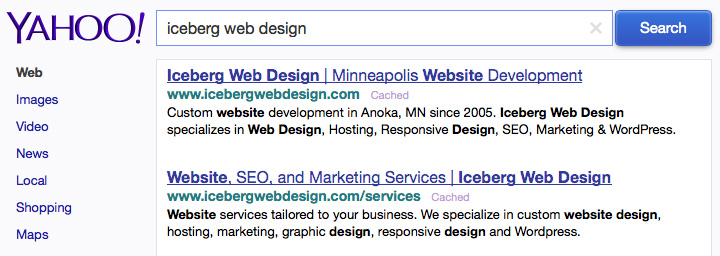Have you ever done a Google Search? If you found this article, then you’re probably familiar enough with Google to know that the results from your search include a brief overview of the websites matching your criteria: a web page title and a short description about the site. The results usually look something like this:
Usually, the page titles are fairly accurate – they are the name of the page listed, and a short description or excerpt from the page content.
Many business owners don’t realize this very basic SEO tip: you can control exactly how search engines display your webpage titles and descriptions.
These identifying pieces of the website that show up in a search are known as meta titles and meta descriptions. The purpose of meta titles and descriptions is to briefly describe the contents of the web page for the searcher. Words that match the specific query you typed in are highlighted in bold, drawing even more attention to some listings. If your website doesn’t specify a title or description, Google (and other search engines) will usually display the website address and a random excerpt from the page. If your content is relevant, this may not be a bad thing. But check out the second result in the image above – Google has pulled text from the navigation menu to display as the website description, because Amazon’s Find Careers by Location page doesn’t directly specify a meta description.
How to change your website’s Title and Description in search results
The process of changing your website’s title and description tags is not too difficult – but depending on how your website is developed, you may need to edit a few blocks of HTML code.
In your website’s coding, there are two lines in the head section that can be edited to customize your website’s search engine display. These are the meta tags for “title” and “description”:
<meta name="title" content="Your website page title here."> <meta name="description" content="Your website description here.">
You can edit these lines of text (or add them in between the <head> and </head> tags if they don’t already exist) for each page on your site – or you can ask your website developer to edit them for you.
If you use a Content Management System like WordPress, there are a number of SEO plugins that you can use that give you control over the meta tags on each page and blog post. Your website developer can also program this functionality into your website’s theme files, or can update them for you.
Tips for writing quality meta tags
You only have a few characters (we’ll get to that in a bit!) to make an impression, so the language you use when writing your meta tags is crucial. A few suggestions to help get the creative juices flowing:
- Start with the product or service you are selling. While a random online shopper may not immediately recognize “Cheryl’s Fashion and Apparel,” but they will surely recognize “Levi’s, Dockers and Other Name Brand Jeans.”
- Sell your product or service! If you’re in a competitive field, start with why you’re the best: “The Largest Selection of Microbrew on Tap!” will speak to your customers more than “Joey’s Bar & Grill: Food and Drinks” will.
- Include your contact information. If your main goal is to get customers in your door or on the phone, make sure your address and phone number are listed in the meta description.
- Be specific and relevant. If you are misleading in your marketing, and your customer does not expect your content when clicking on your link, they will hit the “Back” button. This leaves them with a bad first impression of your business.
- Mix it up. Make sure you update your descriptions when you are running promotions so your search audience is aware of it! If you have seasonal marketing campaigns, don’t forget to update your website to reflect this as well.
Keep it short
You’ve probably already noticed that search engines only display one line of text for the title, and two lines for the description. Having meta tags that are too long will be cut off by search engines. There isn’t a physical limit to how long your meta title or description tags can be – so you can go ahead and ramble on in your description. However, this isn’t going to benefit your business or your search audience, so limiting your words will ensure that your most crucial information is displayed correctly for potential customers.
Meta Titles: 60 characters. One line of text equals about 60 characters. This includes letters, spaces, and punctuation marks.
Meta Descriptions: 155 characters. Google cuts off meta descriptions between 155 and 160 characters. Yahoo, MSN, and others do allow for a few more (up to 180 characters in some search engines) – but you want to write your descriptions for all searchers, so stick to the lower number.
Neet some help?
Give us a call if you’d like some help adding meta titles and descriptions to your website! Need help with writing? We can review your current website and work with you to make sure your site is appearing how you want it to in search engines.





